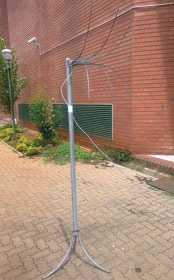

A locally developed antenna for digital terrestrial television has come one step closer to mass production with the official opening of the Tshwane East Manufacturing Incubation Centre (TEMIC).
Incepted as a joint venture between Poynting Antennas and Lawrence Global Manufacturing, the centre will not only be the site where the DigiAnt antenna will be made, but will also provide opportunities for small manufacturing enterprises to actively participate in the digital migration process.
Speaking at the launch event held at the Eerste-rust Civic Centre on 25 February were representatives from Poynting Antennas and Lawrence Global Manufacturing, the chairperson of TEMIC, as well as Tervern Jaftha of the Small Enterprise Development Agency (SEDA) who spoke on behalf of the Department of Trade and Industry (the dti).
Jaftha stated that the joint venture will contribute to the first technology-based incubator for the steel manufacturing sector, and will provide invaluable structural support for small businesses. The joint venture has been made possible in part through a grant obtained by Lawrence Global Manufacturing via the Incubation Support Programme of the dti, with Poynting Antennas contributing 50% of the capital towards the venture.
Eduard Walker, Poynting Antenna’s digital television (DTV) business unit manager and newly appointed director of TEMIC, is also one of the engineers behind the design and technology of the DigiAnt. The antenna is aptly named in that its skeleton has six ant-like ‘legs’ through which the digital signal is conducted.
Walker explained that television antennas have traditionally utilised the Yagi, grid and dipole (or ‘bunny ears’) types of antennas, whereas DigiAnt utilises a Vivaldi Horn antenna. “The DigiAnt signals the first time that this kind of antenna is used in the television environment,” he claimed. “No form of a Vivaldi Horn has previously been commercially used or sold as a television antenna. What we’re looking at here is a totally new type of television antenna in a very old environment.”
What makes the DigiAnt a highly viable solution is a combination of low production costs and ease of manufacture. Its production requires only one process, whereas existing television antennas use multiple processes that are more time consuming and less cost-effective.
Walker says that the DigiAnt, which was demonstrated at the launch, offers sound performance, is 100% locally produced from local products, and is 100% recyclable. Additionally, it comes packaged in a box of 5000 cm², making it compact and easy to transport. This is a key benefit for South Africa’s digital migration process which will require the delivery of around 12 million TV antennas across the country.
Assembly of the DigiAnt is scheduled begin in March this year, and should take six months to reach the pre-production phase locally and a further nine months to meet full capacity. It is anticipated that TEMIC will produce 1,5 million television antennas per year.
| Tel: | +27 12 657 0050 |
| Email: | [email protected] |
| www: | www.intetoconnect.co.za |
| Articles: | More information and articles about Inteto Connect |

© Technews Publishing (Pty) Ltd | All Rights Reserved